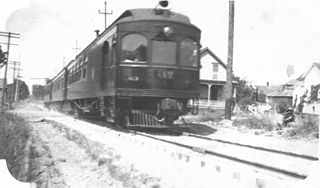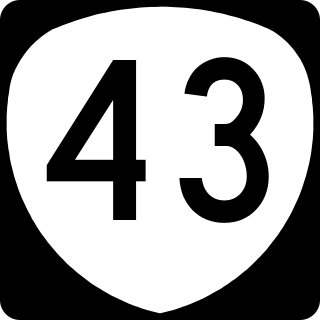
The Oregon Electric Railway (OE) was an interurban railroad line in the U.S. state of Oregon that linked Portland to Eugene.

The Portland and Willamette Valley Railway was incorporated on 19 January 1885 to continue construction of a 3 ft narrow-gauge railroad line between Portland and Dundee, Oregon, United States, which had been started a few years earlier by the Oregonian Railway. The line was opened on 31 December 1886 and the first timetables were published the following day; however, the line did not reach Portland until 23 July 1888, due to disputes over the right-of-way. The railroad company ran this line until it fell into receivership on 2 February 1892.

The Portland metropolitan area is a metro area with its core in the U.S. states of Oregon and Washington. It has 5 principal cities the largest being Portland, Oregon. The U.S. Office of Management and Budget (OMB) identifies it as the Portland–Vancouver–Hillsboro, OR–WA Metropolitan Statistical Area, a metropolitan statistical area used by the United States Census Bureau (USCB) and other entities. The OMB defines the area as comprising Clackamas, Columbia, Multnomah, Washington, and Yamhill Counties in Oregon, and Clark and Skamania Counties in Washington. The area had a population of 2,512,859 at the 2020 census, an increase of over 12% since 2010.

Oregon Route 43 is an Oregon state highway that runs between the cities of Oregon City and Portland, mostly along the western flank of the Willamette River. While it is technically known by the Oregon Department of Transportation as the Oswego Highway No. 3, on maps it is referred to by its route number or by the various street names it has been given.

The Portland and Western Railroad is a 516-mile (830 km) Class II railroad serving the U.S. state of Oregon, and is a wholly owned subsidiary of shortline and regional railroad holding company Genesee & Wyoming Inc. The PNWR includes a subsidiary, the Willamette and Pacific Railroad.

The Willamette Valley Railway is a short-line railroad that operates in the Willamette Valley of Oregon. It leased a line from Woodburn to Stayton from the Southern Pacific Transportation Company in February 1993, as well as a branch from Geer west to Salem, and purchased the property in 1996. The company also leased a line between Albany and Mill City in 1993, but transferred the lease to the Albany and Eastern Railroad in October 2000.

The Westside Express Service (WES) is a commuter rail line in the U.S. state of Oregon serving parts of Washington and Clackamas counties in the Portland metropolitan area. Owned by TriMet and operated by Portland & Western Railroad (P&W), the line is 14.7 miles (23.7 km) long and travels north–south from Beaverton to Wilsonville along a route just west of Oregon Highway 217 and Interstate 5 (I-5). WES consists of five stations and connects with MAX Light Rail at Beaverton Transit Center. Service operates on a 45-minute headway on weekdays during the morning and evening rush hours. In Spring 2022, WES saw a daily ridership of 420 passengers or about 109,000 riders annually.
Rail transportation is an important element of the transportation network in the U.S. state of Oregon. Rail transportation has existed in Oregon in some form since 1855, and the state was a pioneer in development of electric railway systems. While the automobile has displaced many uses of rail in the state, rail remains a key means of moving passengers and freight, both within the state and to points beyond its borders.

The Lake Oswego Railroad Bridge is a truss railroad bridge that spans the Willamette River between Lake Oswego, Oregon and Oak Grove, Oregon. Owned by the Union Pacific Railroad, it is currently leased by the Portland and Western Railroad and carries the Milwaukie branch.

The Oregon Central Rail Road was the name of two railroad companies in the U.S. state of Oregon, each of which claimed federal land grants that had been assigned to the state in 1866 to assist in building a line from Portland south into California. The "East Side Company" of Salem, supported by businessman Ben Holladay, eventually received the grant for its line east of the Willamette River, and was reorganized in 1870 as the Oregon and California Railroad (O&C), which completed the line in 1887. Portland supported the competing "West Side Company", which only built to McMinnville, and was sold to the O&C in 1880. The O&C was later acquired by the Southern Pacific Company, and mostly remains as part of the Union Pacific Railroad's I-5 Corridor; the West Side line is now operated by the Portland and Western Railroad between Beaverton and Forest Grove.

The Oregon Eastern Railway was a predecessor of the Southern Pacific Company that acquired or built most of the Natron Cutoff in northern California and southern Oregon, United States. It also made surveys and acquired right-of-way in eastern Oregon, which were subsequently sold to Union Pacific Railroad subsidiary Oregon–Washington Railroad and Navigation Company.

The Southern Pacific Red Electric Lines, also known simply as the Red Electric, was a network of interurban passenger train services operated by the Southern Pacific Railroad in the Willamette Valley of the U.S. state of Oregon from 1914 to 1929. The service got its name from the bright red color of its cars. Despite its short history, among West Coast interurbans it was unique, and it was considered the finest such system in the Pacific Northwest. It was the only major electric interurban railroad converted from steam to electric passenger use. It was also one of few systems using all-steel equipment, and one of the largest 1500-volt systems in the country.
The Port of Tillamook Bay Railroad is a shortline railroad in northwestern Oregon in the United States. It was established in 1952 to handle switching in Tillamook, Oregon, and came to greater prominence in 1986 when it leased 94 miles (151 km) of the Southern Pacific Railroad's Tillamook branch.

The Forest Grove branch is an abandoned railway line in the state of Oregon, in the United States. It was built by the Oregon Electric Railway and ran 19.1 miles (30.7 km) from Garden Home to Forest Grove via Beaverton and Hillsboro. The MAX Blue Line uses part of the right-of-way between Beaverton and Hillsboro.

The Beaverton and Willsburg Railroad was a railway company in the state of Oregon in the United States. The Southern Pacific established the Beaverton and Willsburg Railroad in 1906 to construct a new cutoff in the vicinity of Portland, Oregon, to run between Beaverton and Milwaukie. The line was completed in 1910 and the company merged into the Southern Pacific in 1916. The cutoff, composed of two separate line segments, remains in use today.
The Newberg branch is a railway line in the state of Oregon, in the United States. It runs 36 miles (58 km) from Portland to a junction with the West Side branch west of Saint Joseph. It was originally built by the Portland and Willamette Valley Railway, a predecessor of the Southern Pacific Transportation Company.
The Tigard branch is a short railway line on the west side of Portland, Oregon, in the United States. It connects the Union Pacific Railroad's West Side branch and Newberg branch. It was originally built in 1910 by the Beaverton and Willsburg Railroad, a subsidiary of the Southern Pacific Transportation Company. The Portland and Western Railroad operates the line, including the WES Commuter Rail service.
The Western Oregon Railroad was a railway company in the state of Oregon in the United States. It was established by the bondholders of the Oregon and California Railroad to further extend the route of the "West Side" Oregon Central Railroad south toward Corvallis, Oregon. All three companies were consolidated in 1880. The Western Oregon's line between St. Joseph and Corvallis is intact and operated by the Portland and Western Railroad.













